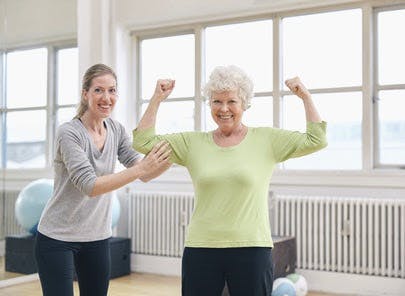Personalized Plans and Attention
Physical therapists are biomechanical specialists who can develop personalized programs that factor in past injuries, the specific type of activities in which people are involved, and their ultimate fitness and competitive goals ranging from marathons and team sports to running and bicycling.
A physical therapy practice offers a safe and therapeutic environment for patients with chronic disease to stay fit while addressing their particular health issues. Those with heart problems, diabetes and neurological conditions can benefit, along with patients who have diseases of the lungs.
The elderly and people with special health issues often refrain from healthy activities due to fear of falling or aggravating their condition. Physical therapists are specially trained in multiple health conditions and their services are effective and safe for pregnant women. Physical therapy is beneficial for more than treating and rehabilitating injuries – it’s a vehicle for lifetime fitness.
Winter Fitness Secrets

For those who dread trips to the gym or fitness center during winter’s inclement weather, physical therapy practices offer custom therapies, training and fitness programs to maintain health and fitness levels, reduce the risk of injury, and perform more efficiently.
Winter weather impacts physical workouts and affects mood, resulting in conditions that includes depression, fatigue and seasonal affective disorder. Physical therapists have techniques and methods to beat the winter blues, elevate mood, maintain fitness levels and prevent weight gain throughout the season.
A physical therapist has the experience and expertise to design a fitness program that maintains current fitness levels, prepares individuals for warmer weather and preserves competitive training schedules. Physical therapy practices also offer an effective alternative for the elderly, those with chronic conditions, and people who don’t feel comfortable within traditional gym environments.
Therapies for Fitness

Our physical therapy techniques address physical and emotional needs during cold winter months when activity and drive are at a low point. Therapeutic massage loosens muscles, increases performance and elevates mood. Massage therapy, acupuncture and dry needling increase energy levels, helps flush toxins from the body and boosts the immune system. It promotes restorative sleep, relieves aches and pains, and improves circulation throughout the body.
Aquatic therapy is an effective resistance training method for those with joint conditions, along with amateur and professional athletes. It’s beneficial for losing weight and allows people to perform motions not possible on dry land.
We offer multiple exercise programs including clinical Pilates, aerobics and yoga that build pelvic and core strength, stability and balance. We identify areas of weakness that need extra attention and perform gait assessments that pinpoints movement dysfunction that reduces efficiency.
Physical therapy practices offer the means to obtain professional training and guidance to stay fit during winter months, reduce the potential for injuries when activities are resumed in the summer and maintain professional training. Therapies are beneficial for relieving stress, anxiety, depression and seasonal conditions that often comes with winter, enabling individuals to greet summer with enthusiasm.
